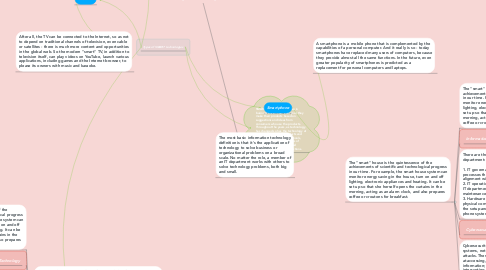Using SMART technologies
by Алтынбек Торехан

1. Types of SMART technologies
2. Smartglasses
3. Smart TV
4. After all, the TV can be connected to the Internet, so as not to depend on traditional channels of television, even cable or satellites - there is much more content and opportunities in the global web. So the modern "smart" TV, in addition to television itself, can play videos on YouTube, launch various applications, including games and the Internet browser, to please its owners with music and karaoke.
5. Smart house
6. There are three primary pillars of responsibility for an IT department: 1. IT governance: This refers to the combination of policies and processes that ensure IT systems are effectively run and in alignment with the organization’s needs. 2. IT operations: This is a catchall category for the daily work of an IT department. This includes providing tech support, network maintenance, security testing and device management duties. 3. Hardware and infrastructure: This focus area refers to all the physical components of IT infrastructure. This pillar of IT includes the setup and maintenance of equipment like routers, servers, phone systems and individual devices like laptops.
6.1. The "smart" house is the quintessence of the achievements of scientific and technological progress in our time. For example, the smart house system can monitor energy saving in the house, turn on and off lighting, electronic appliances and heating. It can be set up so that she herself opens the curtains in the morning, acting as an alarm clock, and also prepares coffee or croutons for breakfast.
6.2. Information Technology
6.3. There are three primary pillars of responsibility for an IT department: 1. IT governance: This refers to the combination of policies and processes that ensure IT systems are effectively run and in alignment with the organization’s needs. 2. IT operations: This is a catchall category for the daily work of an IT department. This includes providing tech support, network maintenance, security testing and device management duties. 3. Hardware and infrastructure: This focus area refers to all the physical components of IT infrastructure. This pillar of IT includes the setup and maintenance of equipment like routers, servers, phone systems and individual devices like laptops.
6.4. Cybersecurity
6.5. Cybersecurity is the practice of protecting systems, networks, and programs from digital attacks. These cyberattacks are usually aimed at accessing, changing, or destroying sensitive information; extorting money from users; or interrupting normal business processes.
7. SMART Technology has been in business since 1986. Each year they make their products based on suggestions and ideas from consumers who use the products. Throughout the years, as technology has changed so has the technology at SMART. Due to their products and how they are used within schools, government, and other areas of business, SMART has received numerous awards and distinctions.
8. Smartphone
9. A smartphone is a mobile phone that is complemented by the capabilities of a personal computer. And it really is so - today smartphones have replaced many users of computers, because they provide almost all the same functions. In the future, even greater popularity of smartphones is predicted as a replacement for personal computers and laptops.
10. Devices, similar to modern "smart" glasses, we have repeatedly seen on the screen of cinemas. The first "smart" glasses can be called an accessory for outdoor activities, which has a built-in camera and allows you to shoot video of your actions. There are also smart glasses that can track your physical condition to give advice on how to become stronger and healthier.
11. The "smart" house is the quintessence of the achievements of scientific and technological progress in our time. For example, the smart house system can monitor energy saving in the house, turn on and off lighting, electronic appliances and heating. It can be set up so that she herself opens the curtains in the morning, acting as an alarm clock, and also prepares coffee or croutons for breakfast.
11.1. The "smart" house is the quintessence of the achievements of scientific and technological progress in our time. For example, the smart house system can monitor energy saving in the house, turn on and off lighting, electronic appliances and heating. It can be set up so that she herself opens the curtains in the morning, acting as an alarm clock, and also prepares coffee or croutons for breakfast.
11.2. Information Technology
11.3. There are three primary pillars of responsibility for an IT department: 1. IT governance: This refers to the combination of policies and processes that ensure IT systems are effectively run and in alignment with the organization’s needs. 2. IT operations: This is a catchall category for the daily work of an IT department. This includes providing tech support, network maintenance, security testing and device management duties. 3. Hardware and infrastructure: This focus area refers to all the physical components of IT infrastructure. This pillar of IT includes the setup and maintenance of equipment like routers, servers, phone systems and individual devices like laptops.
11.4. Cybersecurity
11.5. Cybersecurity is the practice of protecting systems, networks, and programs from digital attacks. These cyberattacks are usually aimed at accessing, changing, or destroying sensitive information; extorting money from users; or interrupting normal business processes.
12. The most basic information technology definition is that it's the application of technology to solve business or organizational problems on a broad scale. No matter the role, a member of an IT department works with others to solve technology problems, both big and small.


